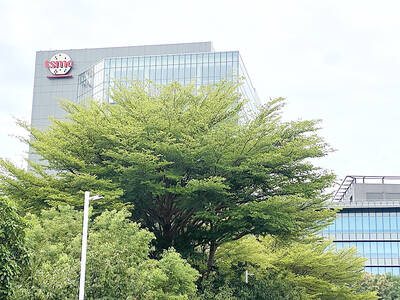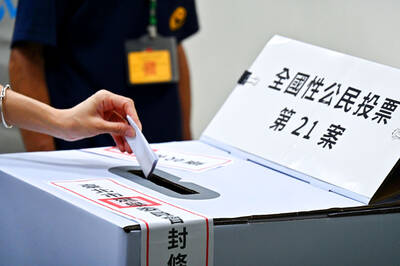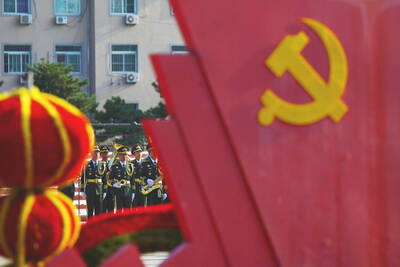The percentage of Taiwanese businesses investing in China has been steadily declining since 2010 due to increased costs, the US-China trade war and the slowdown of China’s economic development, Straits Exchange Foundation (SEF) spokesperson Li Pao-wen (黎寶文) said.
In terms of Taiwan’s total outward investment, the percentage of businesses investing in China has dropped from 83.8 percent in 2010 to 11.4 percent in 2023, 7.5 percent last year and 2.7 percent in the first quarter of this year, Li said in an exclusive interview with Liberty Times, the Taipei Times’ sister paper.
Li said that 70 percent of these businesses experienced a drop in profits last year, and this trend is unlikely to change in the short term.

Photo: Chen Yu-fu, Taipei Times
While the decline in Taiwanese investment in China has mostly been attributed to the New Southbound Policy, this is not actually the case, he said.
Taiwanese investment in regions other than China has been increasing since 2012, before the New Southbound Policy, he added.
Many Taiwanese businesses in 2010 began to feel the impact of China’s investment environment on their profits and started to make changes, he said.
Although the proportion of Taiwanese investments in China exceeded 50 percent in 2012, investment in other regions also reached 40 percent that year, up from 22 percent in 2011, Li said.
This means that Taiwanese investment worldwide increased by 10 percent in a single year, a substantial surge, all before the New Southbound Policy, he said.
Taiwanese businesses began to realize that expenses related to investing in China were rising as its economy developed, Li said.
Labor, environmental and regulation compliance costs were rising, especially in coastal cities, so the advantages of investing in those areas no longer existed, he said.
China has also been bolstering domestic manufacturing, launching the “made in China” initiative with the goal of becoming a major manufacturing power within 10 years, which has created competition for Taiwanese businesses, Li said, adding that combined with the rising costs, Taiwanese businesses began expanding their investments to other countries.
When US President Donald Trump first took office in 2016, the US stopped viewing China as a strategic partner, and launched a trade and tariff war, which increased the risks faced by Taiwanese investing in China, he said.
Previously, products were ordered from Taiwan, produced in China then sold to the US, Li said.
However, as US-China relations worsened, Taiwanese businesses had to find other production sites, he said.
The government noticed this trend and encouraged businesses to return their investments to Taiwan, he added.
“The proportion of Taiwanese businesses investing in China was 7.5 percent last year, reflecting a long-term trend of decline, and it might be even lower this year,” Li said.
The slowdown of China’s economic growth is a disadvantage to Taiwanese businesses, he added.
China recently launched phase two of its “Fuzhou-Matsu integrated living zone” policy, offering incentives for Taiwanese businesses, including Regional Comprehensive Economic Partnership (RCEP) certificates for products exported to Southeast Asia to qualify for lower tariffs.
That blurs the line between “non-red” and “red” supply chains, Li said, adding that issuing RCEP certificates to Taiwanese businesses raises concerns about “origin laundering.”

CHAMPIONS: President Lai congratulated the players’ outstanding performance, cheering them for marking a new milestone in the nation’s baseball history Taiwan on Sunday won their first Little League Baseball World Series (LLBWS) title in 29 years, as Taipei’s Dong Yuan Elementary School defeated a team from Las Vegas 7-0 in the championship game in South Williamsport, Pennsylvania. It was Taiwan’s first championship in the annual tournament since 1996, ending a nearly three-decade drought. “It has been a very long time ... and we finally made it,” Taiwan manager Lai Min-nan (賴敏男) said after the game. Lai said he last managed a Dong Yuan team in at the South Williamsport in 2015, when they were eliminated after four games. “There is

Taiwan Semiconductor Manufacturing Co (TSMC, 台積電) is expected to start construction of its 1.4-nanometer chip manufacturing facilities at the Central Taiwan Science Park (CTSP, 中部科學園區) as early as October, the Chinese-language Liberty Times (the Taipei Times’ sister newspaper) reported yesterday, citing the park administration. TSMC acquired land for the second phase of the park’s expansion in Taichung in June. Large cement, construction and facility engineering companies in central Taiwan have reportedly been receiving bids for TSMC-related projects, the report said. Supply-chain firms estimated that the business opportunities for engineering, equipment and materials supply, and back-end packaging and testing could reach as high as

POWER PLANT POLL: The TPP said the number of ‘yes’ votes showed that the energy policy should be corrected, and the KMT said the result was a win for the people’s voice The government does not rule out advanced nuclear energy generation if it meets the government’s three prerequisites, President William Lai (賴清德) said last night after the number of votes in favor of restarting a nuclear power plant outnumbered the “no” votes in a referendum yesterday. The referendum failed to pass, despite getting more “yes” votes, as the Referendum Act (公民投票法) states that the vote would only pass if the votes in favor account for more than one-fourth of the total number of eligible voters and outnumber the opposing votes. Yesterday’s referendum question was: “Do you agree that the Ma-anshan Nuclear Power Plant

Democratic nations should refrain from attending China’s upcoming large-scale military parade, which Beijing could use to sow discord among democracies, Mainland Affairs Council Deputy Minister Shen You-chung (沈有忠) said. China is scheduled to stage the parade on Wednesday next week to mark the 80th anniversary of Japan’s surrender in World War II. The event is expected to mobilize tens of thousands of participants and prominently showcase China’s military hardware. Speaking at a symposium in Taichung on Thursday, Shen said that Chinese Minister of Foreign Affairs Wang Yi (王毅) recently met with Indian Prime Minister Narendra Modi during a visit to New Delhi.